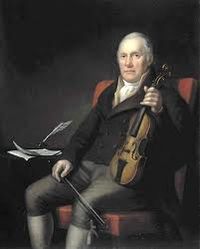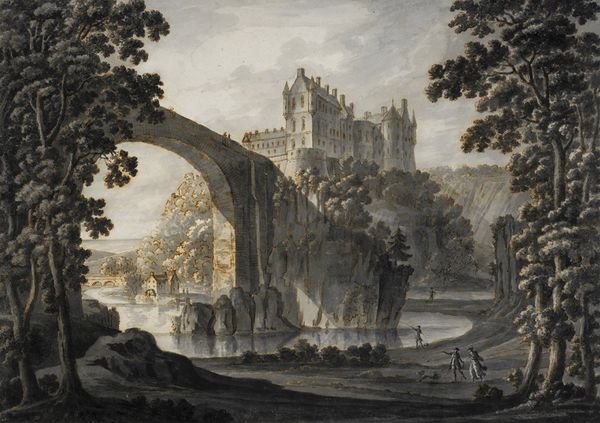Annotation:Cullen House (1): Difference between revisions
Alan Snyder (talk | contribs) (Add link) |
No edit summary |
||
| (3 intermediate revisions by 2 users not shown) | |||
| Line 1: | Line 1: | ||
---------- | |||
---- | {{TuneAnnotation | ||
[[File:marshall.jpg|200px|thumb|left|William Marshall]] | |f_tune_annotation_title= https://tunearch.org/wiki/Annotation:Cullen_House_(1) > | ||
|f_annotation=[[File:marshall.jpg|200px|thumb|left|William Marshall]][[File:Cullenhouse.jpg|thumb|right|600px||An atmospheric and romantic view of Cullen House, painted by the architect Robert Adam in 1779.]]'''CULLEN HOUSE [1]'''. Scottish, Strathspey. A Minor. Standard tuning (fiddle). AAB. Composed by William Marshall (1748–1833). Cullen is in Moray, near Banff, a fishing community for ages. Robert the Bruce established the Old Church there in the 1320's, and his wife, Elizabeth, died at Cullen Castle. The area's prominent family since ancient times were the Oglivies who lived at Findlater Castle, east of Cullen. In the year 1600, however, as the castle structure deteriorated, Cullen House was built close to the church and village and the castle was abandoned (it is an attractive ruin today). In the 17th century Cullen's Laird became Earl of Findlater and when the title became extinct in 1811 with the death of the 7th Earl, Cullen passed to the earls of Seafield. Cullen House was remodelled and extended several times and has at present been converted into luxury homes. Noted architects including William Adam, James Adam, James Playfair and David Bryce were all at various times involved in creating and embellishing one of Scotland's finest houses and designed landscapes. | |||
'''CULLEN HOUSE [1]'''. Scottish, Strathspey. A Minor. Standard tuning (fiddle). AAB. Composed by William Marshall (1748–1833). Cullen is in Moray, near Banff, a fishing community for ages. Robert the Bruce established the Old Church there in the 1320's, and his wife, Elizabeth, died at Cullen Castle. The area's prominent family since ancient times were the Oglivies who lived at Findlater Castle, east of Cullen. In the year 1600, however, as the castle structure deteriorated, Cullen House was built close to the church and village and the castle was abandoned (it is an attractive ruin today). In the 17th century Cullen's Laird became Earl of Findlater and when the title became extinct in 1811 with the death of the 7th Earl, Cullen passed to the earls of Seafield. Cullen House was remodelled and extended several times and has at present been converted into luxury homes. Noted architects including William Adam, James Adam, James Playfair and David Bryce were all at various times involved in creating and embellishing one of Scotland's finest houses and designed landscapes. | |||
<br> | <br> | ||
<br> | <br> | ||
Moyra Cowie ('''The Life and Times of William Marshall''', 1999) records that the Duchess of Gordon, Jane Maxwell (the wife of Marshall's employer, Alexander, the 4th Duke of Gordon) was involved in litigation with James Earl of Findlater and Seafield in the late 1800's. It seems that the Earl attended a ceremony for the completion of the ship The Duchess of Gordon, sheathed on its underside in copper. He was reputedly overheard to say to Brodie of Brodie words to the effect that he 'knew the Duchess had a brass neck and a brazen face but never knew she had a copper arse!' The Duchess, not amused upon hearing of the remark, decided to pursue a case of slander in the courts. Findlater fled to his estate in Saxony, Germany, and never returned. | Moyra Cowie ('''The Life and Times of William Marshall''', 1999) records that the Duchess of Gordon, Jane Maxwell (the wife of Marshall's employer, Alexander, the 4th Duke of Gordon) was involved in litigation with James Earl of Findlater and Seafield in the late 1800's. It seems that the Earl attended a ceremony for the completion of the ship The Duchess of Gordon, sheathed on its underside in copper. He was reputedly overheard to say to Brodie of Brodie words to the effect that he 'knew the Duchess had a brass neck and a brazen face but never knew she had a copper arse!' The Duchess, not amused upon hearing of the remark, decided to pursue a case of slander in the courts. Findlater fled to his estate in Saxony, Germany, and never returned. | ||
|f_source_for_notated_version= | |||
|f_printed_sources=Marshall ('''Fiddlecase Edition'''), 1978; 1822 Collection, p. 58. | |||
|f_recorded_sources= | |||
|f_see_also_listing=Alan Snyder's Cape Breton Fiddle Recordings Index [http://www.cbfiddle.com/rx/tune/t2966.html]<br> | |||
}} | |||
Marshall ('''Fiddlecase Edition'''), 1978; 1822 Collection, p. 58. | |||
Alan Snyder's Cape Breton Fiddle Recordings Index [http://www.cbfiddle.com/rx/tune/t2966.html]<br> | |||
Latest revision as of 18:30, 31 May 2023
X:1 T:Cullen House [1] M:C L:1/8 S:Marshall - 1822 Collection Z:AK/Fiddler's Companion K:Amin c|A,>Ac>A G/G/G B2|A/A/A A>B A/B/c/d/ ec|d>Bc>A G/G/G B>d|e>cd>B c<AA:| f|gg a/g/^f/e/ d<G ~B2|a>e e<a gba^f|gg a/g/^f/e/ dGBd|e>cd>B c<Aaf| gg a/g/^f/e/ d<G ~B2|a>e e<a gba^f|gbeg dGBd|e<c d>B c<AA||


Moyra Cowie (The Life and Times of William Marshall, 1999) records that the Duchess of Gordon, Jane Maxwell (the wife of Marshall's employer, Alexander, the 4th Duke of Gordon) was involved in litigation with James Earl of Findlater and Seafield in the late 1800's. It seems that the Earl attended a ceremony for the completion of the ship The Duchess of Gordon, sheathed on its underside in copper. He was reputedly overheard to say to Brodie of Brodie words to the effect that he 'knew the Duchess had a brass neck and a brazen face but never knew she had a copper arse!' The Duchess, not amused upon hearing of the remark, decided to pursue a case of slander in the courts. Findlater fled to his estate in Saxony, Germany, and never returned.

